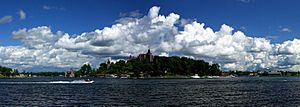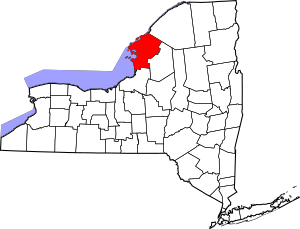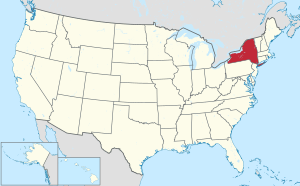Jefferson County, New York facts for kids
Quick facts for kids
Jefferson County
|
|||
|---|---|---|---|

Panoramic view of Boldt Castle on Heart Island
|
|||
|
|||

Location within the U.S. state of New York
|
|||
 New York's location within the U.S. |
|||
| Country | |||
| State | |||
| Founded | 1805 | ||
| Named for | Thomas Jefferson | ||
| Seat | Watertown | ||
| Largest town | Le Ray | ||
| Area | |||
| • Total | 1,857 sq mi (4,810 km2) | ||
| • Land | 1,269 sq mi (3,290 km2) | ||
| • Water | 589 sq mi (1,530 km2) 32% | ||
| Population
(2020)
|
|||
| • Total | 116,721 |
||
| • Density | 63/sq mi (24/km2) | ||
| Time zone | UTC−5 (Eastern) | ||
| • Summer (DST) | UTC−4 (EDT) | ||
| Congressional districts | 21st, 24th | ||
Jefferson County is a county on the northern border of the U.S. state of New York. As of the 2020 census, the population was 116,721. Its county seat is Watertown. The county is named after Thomas Jefferson, third President of the United States of America. It is adjacent to Lake Ontario, southeast from the Canada–US border of Ontario. The county is part of the North Country region of the state.
Jefferson County comprises the Watertown-Fort Drum, NY Metropolitan Statistical Area. The popularity of the area as a summer tourist destination results in a dramatic increase of population during that season.
In 2014, it elected Colleen M. O'Neill as the first woman county sheriff in the state. She had served with the New York State Police for 32 years.
The United States Army's 10th Mountain Division is based at Fort Drum. The base had a total population of nearly 13,000 according to the 2010 census.
Contents
History
When counties were established in the Province of New York in 1683, the present Jefferson County was part of Albany County. This was an enormous county, including the northern part of New York State as well as all of the present State of Vermont and, in theory, extending westward to the Pacific Ocean. This county was reduced in size on July 3, 1766 by the creation of Cumberland County, and further on March 16, 1770 by the creation of Gloucester County, both containing territory now in Vermont.
On March 12, 1772, what was left of Albany County was split into three parts, one remaining under the name Albany County. One of the other pieces, Tryon County, contained the western portion (and thus, since no western boundary was specified, theoretically still extended west to the Pacific). The eastern boundary of Tryon County was approximately 5 miles (8.0 km) west of the present city of Schenectady, and the county included the western part of the Adirondack Mountains and the area west of the West Branch of the Delaware River. The area then designated as Tryon County now includes 37 counties of New York State. The county was named for William Tryon, colonial governor of New York.
In the years subsequent to 1776, most of the Loyalists in Tryon County fled to Canada. In 1784, following the peace treaty that ended the American Revolutionary War, the name of Tryon County was changed to Montgomery County to honor the general, Richard Montgomery, who had captured several places in Canada and died attempting to capture the city of Quebec, replacing the name of the hated British governor.
In 1789, the size of Montgomery County was reduced by the splitting off of Ontario County from Montgomery. The actual area split off from Montgomery County was much larger than the present county, also including the present Allegany, Cattaraugus, Chautauqua, Erie, Genesee, Livingston, Monroe, Niagara, Orleans, Steuben, Wyoming, Yates, and part of Schuyler and Wayne Counties.
Jefferson County is part of Macomb's Purchase of 1791.
In 1791, Herkimer County was one of three counties split off from Montgomery (the other two being Otsego, and Tioga County). This was much larger than the present county, however, and was reduced by a number of subsequent splits. The first one of these, in 1794, produced Onondaga County. This county was larger than the current Onondaga County, including the present Cayuga, Cortland, and part of Oswego Counties.
Oneida County (as well as a part of Chenango County), was split off from Herkimer County in 1798.
Jefferson County was split off from Oneida County in 1805. In 1817, Carleton Island, captured from the British in the War of 1812, was annexed to the county.
Geography
According to the U.S. Census Bureau, the county has a total area of 1,857 square miles (4,810 km2), of which 1,269 square miles (3,290 km2) is land and 589 square miles (1,530 km2) (32%) is water. It is the fourth-largest county in New York by total area.
Jefferson County is in northeastern New York State, adjacent to the area where the Saint Lawrence River exits Lake Ontario. It is northeast of Syracuse, and northwest of Utica. The county is at the international border with Canada.
The Black River, which empties into Lake Ontario, is an important waterway in the county. Part of the Tug Hill Plateau is in the southern part of the county. The county contains part of the Thousand Islands in the St. Lawrence River, including such large islands as Carleton Island, Grindstone Island, and Wellesley Island.
Adjacent counties
- St. Lawrence County – northeast
- Lewis County – southeast
- Oswego County – southwest
- Leeds and Grenville United Counties, Ontario – north
- Frontenac County, Ontario – northwest
Major highways
 Interstate 81
Interstate 81 U.S. Route 11
U.S. Route 11 New York State Route 3
New York State Route 3 New York State Route 3A
New York State Route 3A New York State Route 12
New York State Route 12 New York State Route 12E
New York State Route 12E New York State Route 26
New York State Route 26 New York State Route 37
New York State Route 37 New York State Route 180
New York State Route 180
Demographics
| Historical population | |||
|---|---|---|---|
| Census | Pop. | %± | |
| 1810 | 15,140 | — | |
| 1820 | 32,952 | 117.6% | |
| 1830 | 48,493 | 47.2% | |
| 1840 | 60,984 | 25.8% | |
| 1850 | 68,153 | 11.8% | |
| 1860 | 69,825 | 2.5% | |
| 1870 | 65,415 | −6.3% | |
| 1880 | 66,103 | 1.1% | |
| 1890 | 68,806 | 4.1% | |
| 1900 | 76,748 | 11.5% | |
| 1910 | 80,382 | 4.7% | |
| 1920 | 82,250 | 2.3% | |
| 1930 | 83,574 | 1.6% | |
| 1940 | 84,003 | 0.5% | |
| 1950 | 85,521 | 1.8% | |
| 1960 | 87,835 | 2.7% | |
| 1970 | 88,508 | 0.8% | |
| 1980 | 88,151 | −0.4% | |
| 1990 | 110,943 | 25.9% | |
| 2000 | 111,738 | 0.7% | |
| 2010 | 116,229 | 4.0% | |
| 2020 | 116,721 | 0.4% | |
| U.S. Decennial Census 1790–1960 1900–1990 1990–2000 2020 |
|||
2020 Census
| Race | Num. | Perc. |
|---|---|---|
| White (NH) | 92,755 | 79.5% |
| Black or African American (NH) | 6,271 | 5.4% |
| Native American (NH) | 461 | 0.4% |
| Asian (NH) | 2,185 | 1.9% |
| Pacific Islander (NH) | 300 | 0.3% |
| Other/Mixed (NH) | 6,759 | 5.8% |
| Hispanic or Latino | 7,990 | 6.85% |
Education
Jefferson Community College in Watertown provides higher education within the county.
School districts include:
- Alexandria Central School District
- Belleville Henderson Central School District
- Carthage Central School District
- Copenhagen Central School District
- General Brown Central School District
- Gouverneur Central School District
- Hammond Central School District
- Indian River Central School District
- La Fargeville Central School District
- Lyme Central School District
- Sackets Harbor Central School District
- Sandy Creek Central School District
- South Jefferson Central School District
- Thousand Islands Central School District
- Watertown City School District
Some areas on Fort Drum are not in any school district. Fort Drum sends K-12 students in some portions to the Carthage school district, and others to the Indian River school district.
Communities
City
- Watertown (county seat)
Towns
Villages
Hamlets
All of the hamlets listed, except for Sanfords Four Corners, are also census-designated places.
- Adams Center
- Belleville
- Calcium
- Depauville
- Felts Mills
- Fishers Landing
- Fort Drum
- Great Bend
- Henderson
- La Fargeville
- Lorraine
- Natural Bridge
- Oxbow
- Pamelia Center
- Pierrepont Manor
- Plessis
- Redwood
- Rodman
- Sanfords Four Corners
- Thousand Island Park
- Three Mile Bay
Law enforcement
As of 2021[update] the sheriff is Colleen M. O'Neill. O'Neill is the first female sheriff elected in the state, and was first elected in 2014.
.....
Sites of interest
- Antique Boat Museum
- Boldt Castle
- Burnham Point State Park
- Canoe-Picnic Point State Park
- Cape Vincent
- Carleton Island
- Cedar Point State Park
- Clayton
- Dewolf Point State Park
- Duffy Fairgrounds
- Fairview Manor
- Fort Drum
- Grass Point State Park
- Grenadier Island
- Grindstone Island Upper Schoolhouse
- Lake Ontario National Marine Sanctuary
- National Register of Historic Places listings in Jefferson County, New York
- Orleans
- Paddock Arcade
- Paddock Mansion
- Public Square Historic District
- Roswell P. Flower Memorial Library
- Sackets Harbor
- Sackets Harbor Battlefield State Historic Site
- Thousand Islands
- Thousand Islands National Park
- Tibbetts Point Lighthouse
- Union Hotel (Sackets Harbor, New York)
- Watertown
- Wellesley Island State Park
- Thousand Islands Arts Center
See also
 In Spanish: Condado de Jefferson (Nueva York) para niños
In Spanish: Condado de Jefferson (Nueva York) para niños



